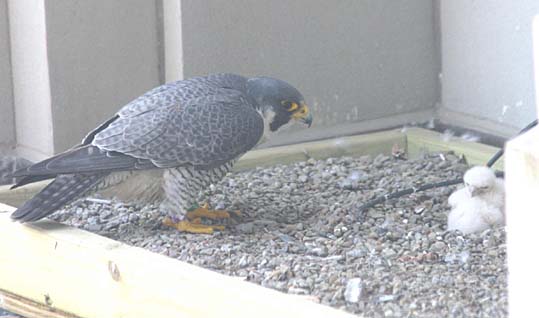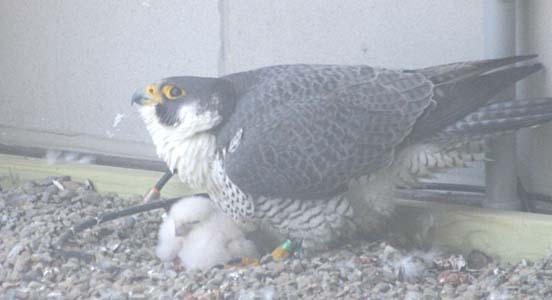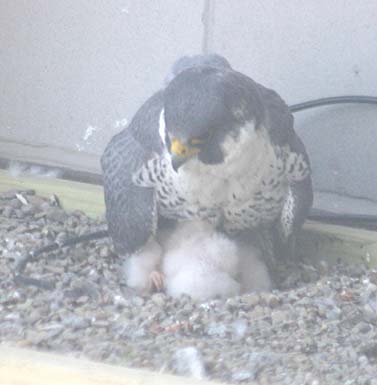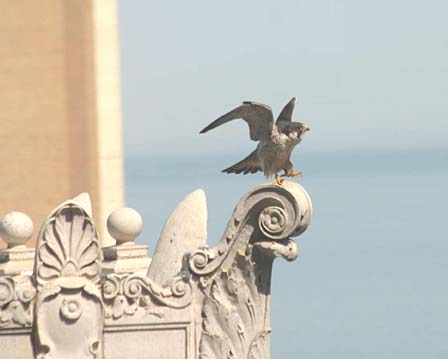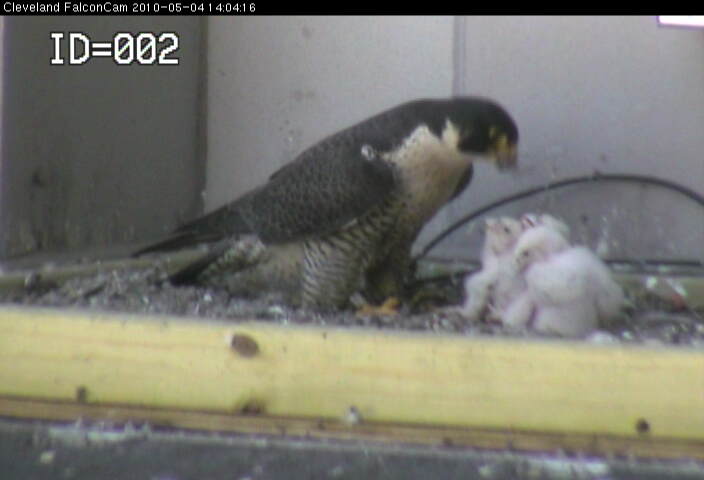FALCON FLASH
Dateline: Cleveland, Ohio
May 4, 2010
The eyasses are about one week old. They cannot self-regulate their body heat yet and the parents cover them whenever it is cool. Volunteer nest monitor, Mr. Scott Wright, described watching Ranger taking over for SW…..
At this point in their lives, the eyasses mostly sleep and eat, and there are several feedings during the day. According to Mr. Wright, “Male falcons will sometimes arrive at the nest with live food, but I have only seen this a few times in my years of monitoring. Most times the impact will stun the food and the talons hold the food until the food becomes food. Most times the male will have killed the prey, clipped the wings, taken off the head, and sent the feathers flying in the wind as he cleans the meal before he feeds his mate and chicks. Many times you cannot even tell what the food was before it was the meal. I have seen the following (not in any order, but by how my mind recalls them) brought into the nestbox: Barn Swallow, Tree Swallow, Red Eyed Vireo, Night Hawk, Black and Yellow-billed Cuckoo, Yellow Warbler, Woodcock, Coot, unknown large Sandpiper, Cedar Waxwing, House Sparrow, Rock Dove, Mourning Dove, unknown Seagull, Red- winged Blackbird, Grackle, Pie-billed Grebe, Robin, unknown Thrush, Song Sparrow, Blue Jay, Flicker, Grey Catbird, Goldfinch..... Many times all you can say is that they brought a LBB to the nest (little Brown Bird) or LGB (little grey bird). What do peregrines eat? Anything that flies that is smaller than them."
Here is Ranger ready to take off to hunt.
For some peregrine families, the smallest eyass sometimes does not get enough to eat, either because of lack of food or because it gets pushed aside by the other eyasses. Ranger is bringing plenty of food to the family, and SW makes sure that all thee get feed. Mr. Wright reports, “We have a runt this year. He/She got pushed out of the way during feeding. SW did a good job making sure it got enough to eat. When she started to feed the young one, she had given it chunks of food that were just way too big. Was she used to giving larger hunks that the other two nest mates could eat? Well, SW then gave him (the runt) very small chunks - not a bunch, but it did get a fair amount”.
Our thanks to the Cleveland Museum of Natural History for sponsoring the FalconCams and for the still.
Photos are courtesy of Scott Wright, volunteer peregrine nest monitor. They may be used by children for school and/or personal projects, but please give Mr. Wright photo credit. All others must contact Mr. Wright directly for permission to use his photos.
